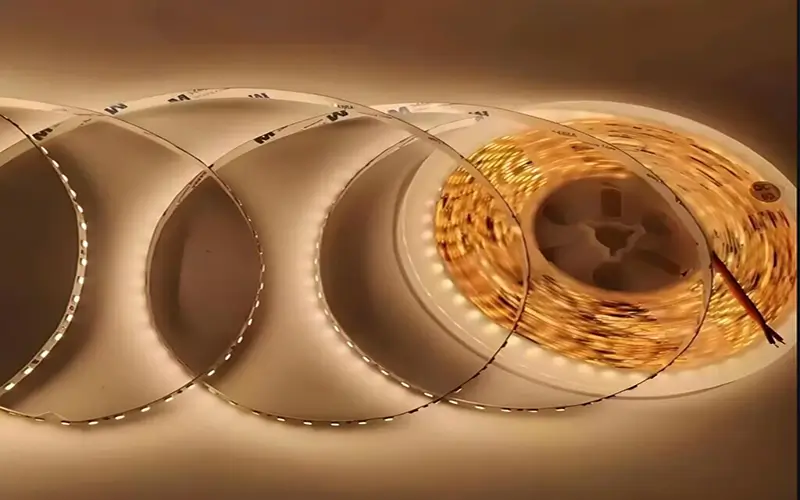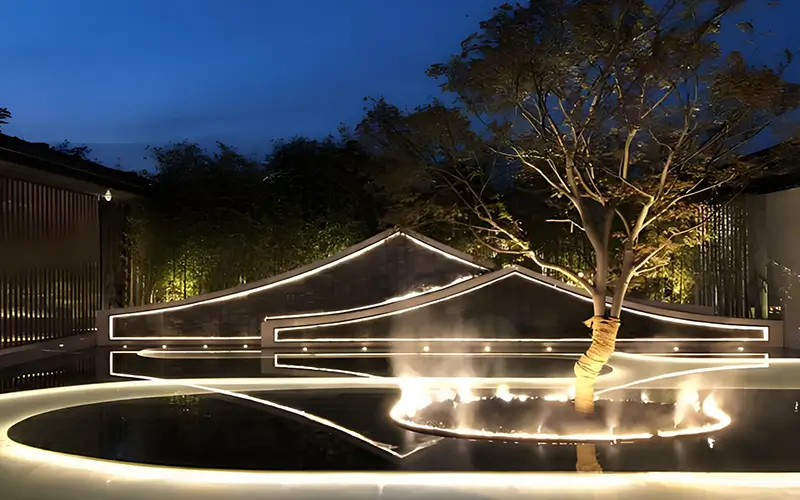
LED light strips have become a popular choice for residential, architectural, and commercial lighting. Their versatility, ease of use, and functionality make them a powerful alternative to traditional lighting options. But what exactly are LED light strips? How do strip lights work? We’ll take a deep dive into the construction, functionality, and various applications of LED light strips.
What is an LED Light Strips?
LED strip light, also known as LED tape or strip light. It is a flexible circuit board with light-emitting diodes (LEDs) mounted on it. You usually mount it on a PCB and encapsulate it in a protective coating if it’s waterproof. Additionally, LED strip lights come in various lengths and densities, allowing customization for specific lighting needs.
LED Strip Lights Construction
The structure of an LED light strip is very simple. Let’s analyze the key components of an LED strip:
LED
The LED is the heart of the light strip, responsible for producing light. And there are many different options, with different models to choose from. Depending on the application, the light strip can use single-color LEDs for lighting effects, or RGB, RGBW, RGBCCT, Dim to Wram, dual color temperature, etc.
Circuit Boards
The LEDs are soldered onto a thin, flexible printed circuit board. The board provides an electrical pathway for current to flow and power the LEDs. The copper traces etched into the board act as conductors. We can customize the length of the board, typically 5 meters.
Resistors
Parts on some circuit boards, such as resistors and ICs. These components regulate the current to ensure that the LEDs operate within their optimal parameters.
Waterproof Coating
If you choose a waterproof-rated LED light strip, it is for use in wet and outdoor areas. Manufacturers typically use materials like epoxy resin to coat the PCB and LED, protecting them from physical damage and providing waterproofing. 6 Different Ways to LED Strips Light Waterproof
3M Adhesive Backing
The strong 3M adhesive backing on the light strip easily adheres to a clean and dry surface.
How Do LED Light Strips Shine?
The properties of the LED primarily distinguish LED strips. When current passes through an LED, it excites the electrons within the device, causing it to release energy in the form of light. The specific color of the light emitted depends on the materials used to construct the LED.

How Strip Lights Work:
- Power supply: LED strips require a power source to power them. Generally, you power LED strips using low voltage, typically 12V or 24V, with a low voltage DC (direct current) adapter.
- Voltage regulation: Resistors on the circuit board can be used to regulate the voltage received by the LEDs. This ensures uniform brightness and prevents damage caused by excessive voltage.
- Current flow: Current from the power source flows through the copper wires on the circuit board.
- LED activation: When current reaches the LEDs, they light up, emitting their characteristic color.
Types of LED Strips
LED strips are available in a variety of LED types, colors, and color temperatures, and each strip is designed to meet specific needs. Here are some common types:
Monochrome LED Strips
Monochrome LED strips emit a single color of light. For example, warm white 2700K, cool white 6500K, or a specific color temperature.
Dimmable LED Strips
Dimmable LED strips have two color temperatures mixed. The conventional choice is 2700K and 6000K, which satisfies the comfort of warm white while enjoying the focus of cool white. by the way, these strips can be dimmed to adjust the overall brightness level.
RGB LED Strips
These strips contain LEDs that produce red, green, and blue light. You can mix these three colors. By varying the intensity of each LED, millions of colors can be created.
Addressable LED Strips
Addressable LED Strips are very advanced and trendy LED strips, these advanced strips allow for individual control of each LED on the strip. They can be programmed to create complex light effects and patterns.
Swimming Pool LED Strips
Swimming Pool LED Strips are special strip of lights that are made specifically for swimming pools and underwater units. These strips are designed for use in swimming pools and are waterproof up to IP68, making them safe for use in swimming pools. I recommend our IP68 neon tubes, which you can use in swimming pools and underwater with confidence. If you need to choose the LED neon flex, pls read How to Choose LED Neon Flex Lights for Swimming Pool?
Advantages of LED Light Strips
LED light strips offer several advantages over traditional lighting options. For example, energy saving, flexibility, and customization:
Energy Savings
LED light strips consume much less energy than incandescent and fluorescent lamps. Because they are LED, they are very energy-efficient. Helps to reduce electricity bills and reduce environmental impact.
Long Lifespan
LED light strips can last up to 50,000 hours or more, which means fewer replacements and lower maintenance costs.
Flexibility
The flexibility of light strips makes them easy to install on curved surfaces or in tight spaces. Custom lengths are supported, and you can also cut them yourself.
Customizable Lighting
LED light strips can be dimmed and programmed, also to create dynamic lighting effects that enhance the atmosphere in any environment.
How to Properly Install LED Strip Lights?
Installing LED light strips is usually a simple process, and make sure the work of strip lights. Here are the basic guidelines:
Plan the area: Measure the area where you want to install the LED strip lights and determine where to place the strip lights for optimal lighting.
Surface preparation: Keep the surface clean, clean the mounting surface thoroughly and ensure that the strip lights are firmly bonded.
Cutting and connecting: LED strip lights can usually be cut to fit the required length at designated cutting points. Make sure the strip segments are properly aligned and connected.
Installation: Remove the adhesive backing and press the strip lights firmly onto a clean surface. If necessary, use additional mounting clips or LED aluminum profiles for added security.
LED power supply: Connect the LED strip lights to a suitable power supply, ensuring that the voltage and current ratings match the requirements of the strip lights to avoid damage.
Control options: Depending on the type of LED strip lights, control options may include a remote control, smartphone app, or wall-mounted controller for adjusting brightness, color, and lighting modes.
Conclusion
In short, LED light strips represent a major advancement in lighting technology. You can fully understand the work of LED strip lights so that you can choose LED light strips more correctly. It has completely changed the lighting landscape with unparalleled flexibility, color and lighting modes. Whether it is a DIY enthusiast or a lighting design company, it is easy to select and install LED light strips. We are an LED strip lights manufacturer. Please let me know if you have any inquiries.
